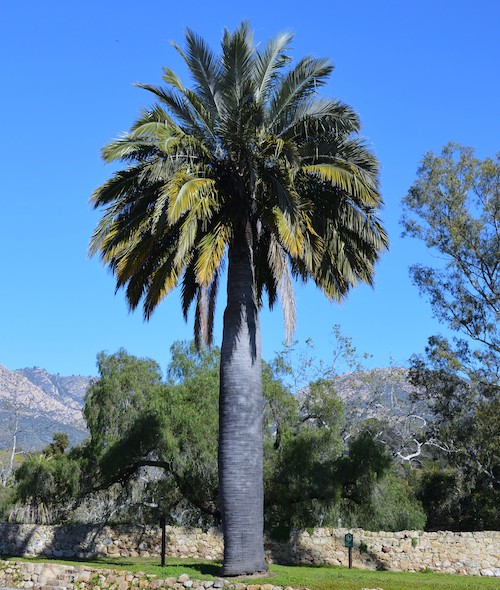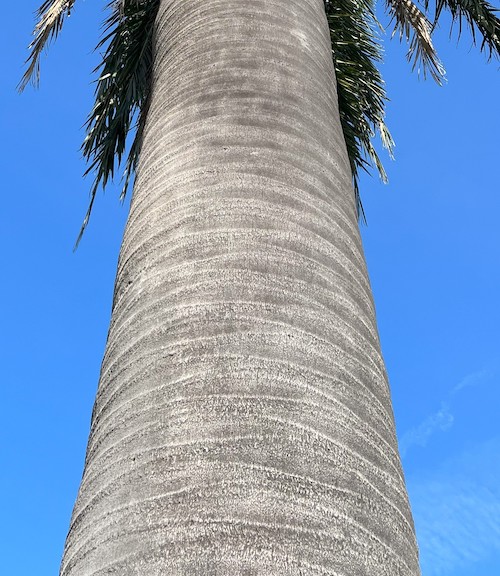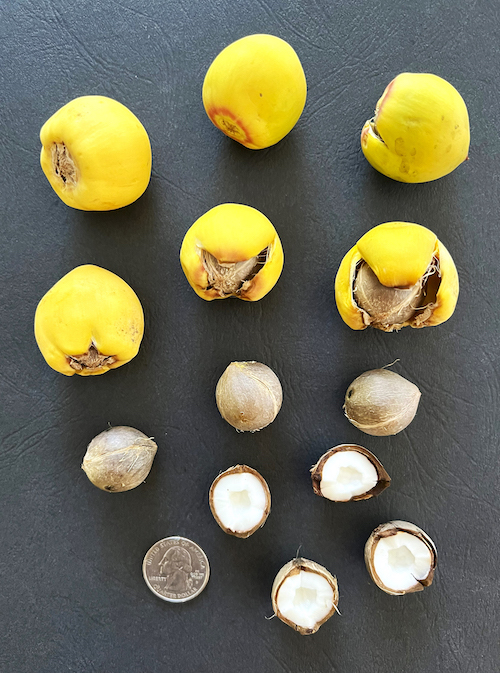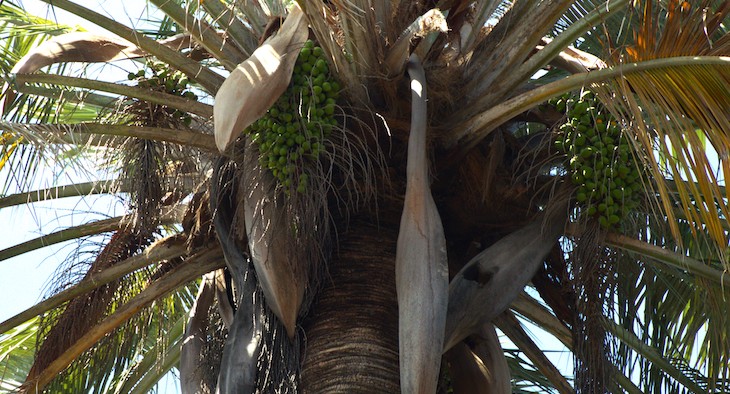By David Gress
The majestic and stately Chilean Wine Palm is truly extraordinary. It is the largest palm in the Western Hemisphere. Until recently, its massive trunk had earned it the title of the largest palm in the entire world – until the larger African Fan Palm (Borassus aethiopum) was discovered. Nonetheless, it is awe inspiring to see any palm of this size.
Seeds of Chilean Wine Palm were brought to California in the mid-1800s. Young specimens were available for purchase at Ralph Kinton Steven’s nursery here in Santa Barbara, from 1882 until his death in 1896. The remaining thirty-seven acres of that nursery are now the grounds of Ganna Walska Lotusland, where many fine specimens of his enormous palms still stand.
Amazingly, Chilean Wine Palm is so cold-hardy that it grows as far north as England, Ireland, and Victoria, British Columbia. More importantly, it grows exceedingly well in our Mediterranean climate, which is very similar to its native habitat in Chile.

Chilean Wine Palm has a straight single trunk that grows slowly to over 80 feet tall. This great trunk height is interesting, since it can take several decades before a trunk even begins to develop on young palms.
At maturity, the trunk is widest at the base (3- to 5-feet (or more!) in diameter). After attaining some 30- to 40-feet in height, the trunk gradually narrows to half of that width. This narrowing results in a fully grown palm having the appearance of an elongated wine bottle – and makes identification easy. In addition to its tremendous size and odd shape, the elephant-gray trunk is further distinguished by its smooth texture, which is only marred by faint horizontal scars where shed fronds had previously been attached. It is astoundingly hard – as if made from gray concrete.
The trunk is topped with a large crown, consisting of 40 to 50 arching pinnate (feather-like) fronds (6- to 12-feet long), which stand on a petiole (stem) (1½- to 3-feet long) that bears stiff hairs but no spines. Each frond has many leaflets (to 2-feet long, 1-inch wide).

As with most palms, on seedlings the juvenile fronds are simple (unsegmented) for several years. Once the seedling stage has passed, on young trees the fronds are straight, rigid, and often stand quite upright. As the tree matures, pinnate fronds emerge glaucus (bluish green) or in various shades of gray-green, depending on genetic variability.
Chilean Wine Palm is monoecious, meaning each tree produces both male and female flowers. From April to June, the small (1/2-inch diameter) flowers bloom – maroon in color with a yellow-white center. Large (2- to 3-feet long) clusters of flowers emerge from between fronds. The flower clusters are usually very difficult to see from the ground, because they are almost entirely shielded from view by a persistent woody bract (envelope-like sheath) until the fruit is fully formed. However, fallen flowers, like dainty snowflakes, often cover the ground at the base of the trunk.
After pollination, female flowers produce clusters of globose fruit (1½-inch long) covered by an orange-yellow fibrous skin. In late summer to early fall, the fruits ripen and then drop to the ground. Under the fruit skin, there is a round (1-inch diameter) brown nut, which looks like a miniature coconut. When cracked open, the nut reveals a white meat that has the look, texture, and taste of true coconut. In Chile, the nut is called “coquito nut”.

As can be inferred from its name, the Chilean Wine Palm is native to Chile, and is endemic to that country’s central Coastal Range. This palm once covered vast areas in this area, before its numbers were decimated by loggers who harvested it for its trunk sap. As its name also suggests, the trunk sap was boiled down to make a syrup called “palm honey”, which was then fermented or distilled to produce alcoholic beverages called “palm wine”.
Unfortunately, the palm wine making process required that each magnificent palm be killed – cut down and drained of its “life blood” – simply to collect up to 90 gallons of its trunk sap.
Fortunately, with protections currently in place in Chile, this logging practice is now legally restricted. Almost all Chilean Wine Palm populations in Chile are presently confined to designated preserves. While there are an estimated 100,000 palms in these preserves, Chilean Wine Palm is still listed as endangered by some conservation organizations. Its preservation is aided by the fact that is being planted – and enjoyed only for its beauty – in many other parts of the world that have suitable climates. – like ours.
Chilean Wine Palm is also known by several other common names: “Chile Cocopalm”; “Syrup Palm”; “Honey Palm”, “Coquito Palm”; and, “Palma Chilena”. Its botanical name is Jubaea chilensis. It is the only species in its genus. The genus name, Jubaea, is derived from the name of Juba (85 B.C. to 46 B.C), who was the king of Numidia (present day Algeria) before the Roman invasion. The specific epithet, chilensis, means that it is native to Chile.
This remarkable palm is both cold-hardy (able to tolerate temperature, for brief periods, down to 5 degrees F.) and drought-tolerant. However, it seems to grow best in a Mediterranean climate, because it does not like excessive heat, humidity, or moisture. It will not survive either salt spray or salty soil, so it is best to keep it away from beach areas. It can live in clay soils – but prefers a well-drained sandy loam. When a palm is young, overhead watering is discouraged, because it may result in “bud rot” – the infestation of the apical meristem (the growing point of new fronds) by a plant pathogen (Phytophthora palmivora) – that will end in the death of a young palm.
Propagation with fresh seeds is easy – but requires considerable patience, since it can take 1 to 2 years for them to germinate! Growth is painfully slow at the earlier stages – but it accelerates once seedlings are planted out in an area with favorable growing conditions. Occasional ground watering during the dry season and an annual application of slow-release fertilizer can also speed growth.
While Chilean Wine Palm is not a palm for small gardens or spaces, it does make an impressive addition to a suitable park or larger property. It can be planted as a single handsome specimen – or planted in a row or a grouping for great dramatic effect.
Mature specimens of Chilean Wine Palms can be seen in several places in our community: in East and West Alameda Park; in Mission Park, on the south side of Los Olivos Street, right across from the front doors of the Mission (2 palms); in the Santa Barbara Cemetery; in the front yard of 2044 Garden Street (2 palms); in the front yard of 2005 Laguna Street (2 palms); at the Stow House in Goleta (3 palms); and, most notably, at Ganna Walska Lotusland (over 40 palms), including two standing on either side of the old main gate on Sycamore Canyon Road at the intersection of Eucalyptus Hill Road.
Tree-of-the-Month articles are sponsored by Santa Barbara Beautiful, whose many missions include the increase of public awareness and appreciation of Santa Barbara’s many outstanding trees and, in a long-time partnership with the City Parks & Recreation Department, the funding and planting of trees along the City’s streets.
Those who wish to honor a special someone can do so with an attractive commemorative marker that will be installed at the base of an existing street tree in the City of Santa Barbara. Because Santa Barbara Beautiful has participated in the planting to date of over 13,000 street trees, there are plenty of trees from which to choose! Application forms are available on the Santa Barbara Beautiful website, www.sbbeautiful.org.
Article and Photos by David Gress







Thank you!
Nice discussion. There is a nice specimen on the North side of Hollister just West of Patterson. Although it does not have the trunk girth the Bismarkia nobilis I believe it has a crown spread larger than Jubaea. There is one t Lotusland that must have a 25-30 foot wide crown.
There is a Chilean Wine Palm on the left side of De La vina Street driving towards the Ocean past Victoria on the Santa Barbara Lawn Bowls Club property!
This one:
https://www.google.com/maps/@34.421771,-119.707503,3a,89.3y,14.46h,113.59t/data=!3m6!1e1!3m4!1snK7EEsl3JpsGkwaZxVwjVw!2e0!7i16384!8i8192?entry=ttu